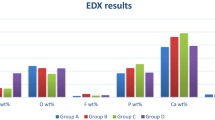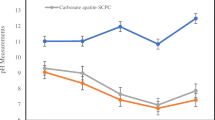Abstract
We explored chitosan-based sustained release pastes for apexification. The study aimed to formulate chitosan-based pastes loaded with calcium hydroxide (CH) or with calcium chloride (CC), and to evaluate the sustained release of Ca2+ and pH changes in deionized water as well as the effect of the pastes on cell viability. The pastes were formulated by dissolution of the chitosan in 1% or 2% acetic acid (AAC) plus the addition of CH or CC, then were suspended in deionized water for 50 days; the released Ca(II) and pH were measured with an electrode probe. The effect of the pastes on viability of human dental pulp cells was evaluated with a MTS assay. The results showed that the pastes prepared with 1% and 2% AAC and loaded with CH released a 74.9% and a 76.1% of the Ca2+ content, respectively, while the pastes prepared with 1% and 2% AAC loaded with CC released a content of Ca2+ of 90.8% and 76.6%, respectively. A control paste (CH and polyethylene glycol) released a 95.4%; significant statistical differences were found between the percentage of the experimental pastes and the control. The CH-loaded pastes caused an alkaline pH at the starting of the study, but the pH became neutral at the ending. The pH of the CC-loaded pastes was neutral at the starting and was acid at the ending. The pastes no affected on the cell viability. The chitosan-based pastes showed a suitable sustained release profile and cytocompatibility.




Similar content being viewed by others
References
Rafter M. Apexification: a review. Dent Traumatol. 2005;21:1–8.
Mohammadi Z, Dummer PM. Properties and applications of calcium hydroxide in endodontics and dental traumatology. Int Endod J. 2011;44:697–730.
Galler KM, Krastl G, Simon S, et al. European Society of Endodontology position statement: revitalization procedures. Int Endod J. 2016;49:717–23.
Miltiadous M-EA, Floratos SG. Regenerative endodontic treatment as a retreatment option for a tooth with open apex—a case report. Braz Dental. 2015;26:552–6.
Asgary S, Fazlyab M, Nosrat A. Regenerative endodontic treatment versus apical plug in immature teeth: three-year follow-up. J Clin Pediatr Dent. 2016;40:356–60.
Segura-Egea JJ, Gould K, Şen BH, et al. European Society of Endodontology position statement: the use of antibiotics in endodontics. Int Endod J. 2018; 51:20–25.
Segura-Egea JJ, Gould K, Şen BH, et al. Antibiotics in endodontics: a review. Int Endod J. 2018;50:1169–1184.
Paula-Silva FW, Ghosh A, Arzate H, et al. Calcium hydroxide promotes cementogenesis and induces cementoblastic differentiation of mesenchymal periodontal ligament cells in a CEMP1- and ERK-dependent manner. Calcif Tissue Int. 2010;87:144–57.
Abbott PV. Apexification with calcium hydroxide—when should the dressing be changed? The case for regular dressing changes. Aust Endod J. 1998;24:27–32.
Soares J, Santos S, Cesar C, et al. Calcium hydroxide induced apexification with apical root development: a clinical case report. Int Endod J. 2008;41:710–9.
Fava LR, Saunders WP. Calcium hydroxide pastes: classification and clinical indications. Int Endod J. 1999;32:257–82.
Silveira CM, Sebrao CC, Vilanova LS, Sanchez-Ayala A. Apexification of an immature permanent incisor with the use of calcium hydroxide: 16-year follow-up of a case. Case Rep Dent. 2015;2015:984590.
Cerda-Cristerna BI, Breceda-Leija A, Mendez-Gonzalez V, et al. Sustained release of calcium hydroxide from poly(DL-lactide-co-glycolide) acid microspheres for apexification. Odontology. 2016;104:318–23.
Schmitz MS, Montagner F, Flores CB, et al. Management of dens invaginatus type I and open apex: report of three cases. J Endod. 2010;36:1079–85.
Yassen GH, Chin J, Mohammedsharif AG, et al. The effect of frequency of calcium hydroxide dressing change and various pre- and inter-operative factors on the endodontic treatment of traumatized immature permanent incisors. Dent Traumatol. 2012;28:296–301.
Ahmadi F, Oveisi Z, Samani SM, Amoozgar Z. Chitosan based hydrogels: characteristics and pharmaceutical applications. Res Pharm Sci. 2015;10:1–16.
Rinaudo M, Pavlov G, Desbrières J. Influence of acetic acid concentration on the solubilization of chitosan. Polymer. 1999;40:7029–32.
Rinaudo M, Pavlov G, Desbrieres J. SoIubiIization of chitosan in strong acid medium. Int J Polym Anal Charact. 1999;5:267–76.
Ballal NV, Shavi GV, Kumar R, Kundabala M, Bhat KS. In vitro sustained release of calcium ions and pH maintenance from different vehicles containing calcium hydroxide. J Endod. 2010;36:862–6.
Grover C, Shetty N. Evaluation of calcium ion release and change in pH on combining calcium hydroxide with different vehicles. Contemp Clin Dent. 2014;5:434–9.
Huang M, Khor E, Lim L-Y. Uptake and cytotoxicity of chitosan molecules and nanoparticles: effects of molecular weight and degree of deacetylation. Pharma Res. 2004;21:344–53.
Ranaldi G, Marigliano I, Vespignani I, Perozzi G, Sambuy Y. The effect of chitosan and other polycations on tight junction permeability in the human intestinal Caco-2 cell line. J Nutr Biochem. 2002;13:157–67.
Escobar-García M, Rodríguez-Contreras K, Ruiz-Rodríguez S, et al. Eugenol toxicity in human dental pulp fibroblasts of primary teeth. J Clin Pediatr Dent. 2016;40:312–8.
Vold IMN, Vårum KM, Guibal E, Smidsrød O. Binding of ions to chitosan—selectivity studies. Carbohydr Polym. 2003;54:471–7.
Varma AJ, Deshpande SV, Kennedy JF. Metal complexation by chitosan and its derivatives: a review. Carbohydr Polym. 2004;55:77–93.
Graham L, Cooper PR, Cassidy N, et al. The effect of calcium hydroxide on solubilisation of bio-active dentine matrix components. Biomaterials. 2006;27:2865–73.
Mizuno M, Banzai Y. Calcium ion release from calcium hydroxide stimulated fibronectin gene expression in dental pulp cells and the differentiation of dental pulp cells to mineralized tissue forming cells by fibronectin. Int Endod J. 2008;41:933–8.
An S, Gao Y, Ling J, Wei X, ** materials. J Mater Sci Mater Med. 2012;23:789–95.
Acknowledgements
Juan Carlos Flores Arriaga was supported by CONACYT: Scholarship Number 334417. We thank to Professor Ernesto Acosta Sandoval for the editing of the language of the manuscript. The authors declare no conflict of interest.
Author information
Authors and Affiliations
Corresponding author
Ethics declarations
Conflict of interest
The authors declare that they have no conflict of interest.
Rights and permissions
About this article
Cite this article
Flores-Arriaga, J.C., Pozos-Guillén, A.d.J., González-Ortega, O. et al. Calcium sustained release, pH changes and cell viability induced by chitosan-based pastes for apexification. Odontology 107, 223–230 (2019). https://doi.org/10.1007/s10266-018-0389-7
Received:
Accepted:
Published:
Issue Date:
DOI: https://doi.org/10.1007/s10266-018-0389-7




